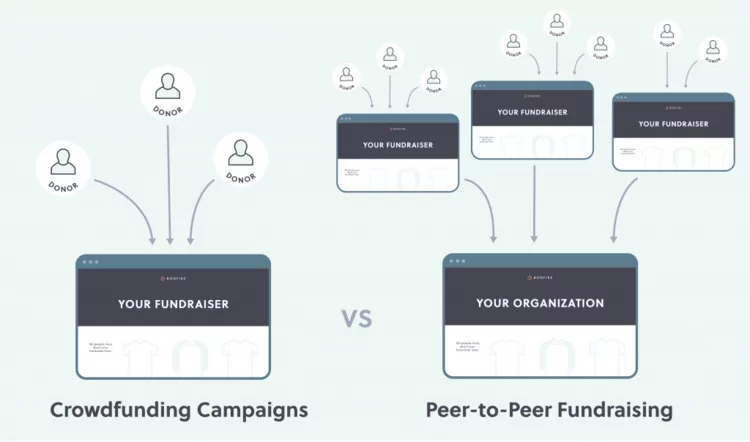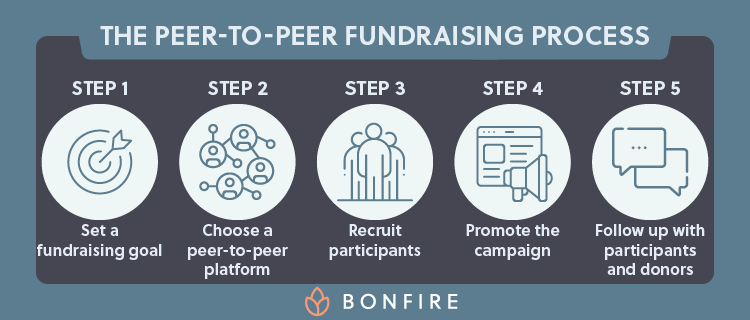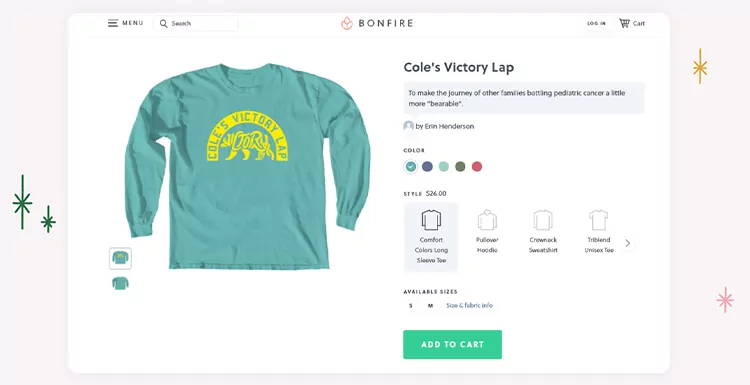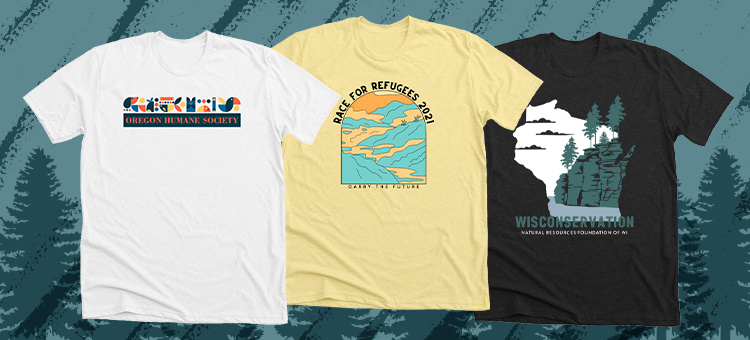Imagine harnessing the power of your donors to raise money on your behalf, while strengthening your nonprofit’s relationship with those donors at the same time. Peer-to-peer fundraising makes it possible to do just that!
With peer-to-peer fundraising, you can raise money, multiply your audience, and strengthen connections with existing supporters in one fell swoop.
If your nonprofit is considering launching its first peer-to-peer fundraiser, or if you’re looking for a refresher on best practices, you’re in the right place. Whether you’re a first-time campaign manager or a seasoned professional, we’ll answer any questions that you might have, including:
Peer-to-peer fundraising is a powerful way to maximize donations and supporter relationships. Let’s dive in so you can start preparing for your next campaign.s, but only if you’re equipped with the knowledge and motivation to do so. Let’s dive in so you can start preparing for your next campaign.
What is Peer-to-Peer Fundraising?
Peer-to-peer fundraising is a social fundraising strategy where individuals collect donations from their friends, families, and other peers on behalf of a nonprofit organization.
Volunteer fundraisers create individual online campaign pages, set goals for how much they want to raise, and leverage their existing social networks to ask for donations. When the fundraiser ends, the money raised by these dedicated volunteers goes straight to the nonprofit organization.
What’s the Difference Between Crowdfunding and Peer-to-Peer Fundraising?
As its name suggests, crowdfunding refers to securing funding from the crowd. The organization’s fundraising team organizes a campaign page and then asks many individuals to donate — typically smaller donations like $5, $10, or $50 — to fund a specific project or cause.


Peer-to-peer fundraising is a multi-tiered approach to crowdfunding. You recruit participants who then create personal fundraising pages that their friends and family donate to — hence the term “peer-to-peer.” Rather than requesting donations from one audience, you have a large group sourcing donations from a number of different networks.
What Are the Benefits of Peer-to-Peer Fundraising?
If you’re considering hosting a peer-to-peer fundraiser but aren’t sure if it’s the best avenue, here are some of the benefits you can expect from hosting one:
- Organically raise money. The individuals who create fundraising pages on your behalf do so because they care about your cause. This personal investment in your cause makes it easier and more natural for them to share the fundraiser with their friends and family.
- Spread brand awareness to new audiences. During these fundraisers, your donors are encouraged to fundraise from their personal networks. Especially when you incorporate factors such as branded apparel, you’ll get your nonprofit’s brand in front of more people and connect with new supporters who you might not otherwise come into contact with.
- Deepen participants’ engagement. When participants gain hands-on fundraising experience and play a direct role in your campaigns, they’ll feel personally responsible for the success of your cause.
- Leverage social proof to establish trust and maximize donations. People are more likely to engage if their friends — who they have personal relationships — with are the ones soliciting donations. They feel a connection with the person asking for contributions and will want to support their interests.
- Maximize your resources. Save your resources and reduce your team’s workload by placing fundraising responsibilities on your donors. While peer-to-peer campaigns are not totally hands-off, they are great for organizations lacking time or budget that have a strong donor network.
You can see why so many nonprofits turn to peer-to-peer fundraising as part of their regular development efforts. Between solidifying existing relationships to forming new ones, your nonprofit can’t go wrong by pursuing this method.
What Are The Different Types of Peer-to-Peer Fundraising Campaigns?
There are three different types of peer-to-peer fundraising campaigns that you could run: rolling campaigns, time-based campaigns, and giving days.
The one you choose will depend on your nonprofit’s available resources, donor relationships, needs, and goals. Here’s more about each type of campaign to help you decide:
Rolling Campaigns
Rolling peer-to-peer fundraising campaigns go on indefinitely and are usually intended for general fundraising purposes. Market these campaigns using your social media posts, monthly newsletters, and website so users can easily donate or launch their own campaigns.
This type of campaign fits into your supporters’ life events, making it easy for them to launch a campaign near their birthday, holiday, or just because they want to support their favorite nonprofit!
Time-Based Campaigns
Time-based peer-to-peer fundraising campaigns take place within a specific timeframe (commonly around 6 to 8 weeks) and are usually tied to a theme or fundraising event. Some of the most common events for time-based campaigns include walk-a-thons, 5Ks or 10Ks, bowl-a-thons, and golf outings.
This type of peer-to-peer fundraiser takes more forethought when it comes to scheduling and proactively marketing the campaign to drive donations.
Giving Days
Peer-to-peer giving days challenge donors to reach a set goal — or raise as much money as they can — within 24 hours. A great example of this is Giving Tuesday, an annual global generosity movement that occurs on the Tuesday after Thanksgiving to offset the impacts of Black Friday and Cyber Monday consumerism. Challenge your donors to raise as much money as possible through peer-to-peer fundraising during one of the most charitable days of the year.
Alternatively, schedule a giving day on any other day. Many nonprofits choose a day related to their cause. For example, the World Wildlife Fund might organize a peer-to-peer giving day fundraiser on Earth Day. These campaigns create urgency for your supporters and donors, driving them to help you reach your goal in this short period of time.
How Does Peer-to-Peer Fundraising Work?
Peer-to-peer fundraising is a straightforward process that you’ll need to understand before you can successfully organize your campaign. Let’s break it down into steps.


1. Set a Fundraising Goal
Before forming a team and securing donations, your nonprofit needs to set a goal for the campaign. This goal will be a major driving force for your peer-to-peer fundraiser. It gives everyone an overarching objective to work toward and provides participants with a reference point when creating their personal goals.
There are two types of goals to consider:
- Financial goals. This is simply how much money your nonprofit wants to raise. Remember to consider factors outside of individual contributions, such as sponsorships and registrations if your campaign will end with an event.
- Non-financial goals. These goals are more ambiguous and typically pertain to how your organization can grow its audience and impact. For example, one of your non-financial goals could be recruiting a certain number of new donors to your organization.
As a rule of thumb, your nonprofit should set achievable yet aspirational goals within both of these categories, using past campaign results as a reference point for what you’re capable of achieving. Bear in mind that your goals should also be achievable within the time frame you have in mind.
2. Choose a Peer-to-Peer Fundraising Platform


Like any other online fundraiser, your nonprofit needs the right technology to get the job done. A dedicated peer-to-peer fundraising platform empowers your donors to create their own campaign pages and collect donations from their friends and families. They won’t have to worry about doing anything other than customizing their campaign page to emphasize their connection to your cause and sharing that page online.
Choose a platform that:
- Makes it easy to get up and running. Your nonprofit should be able to customize its profile, and peer-to-peer participants should be able to add text, images, and videos to their campaigns within a few minutes.
- Limits upfront costs to your organization. That way, all the money your supporters raise will go directly to your nonprofit, rather than to pay the platform’s fees.
- Provides donors’ contact information. One of the benefits of peer-to-peer fundraising is reaching new donors. Make sure you can access each supporter’s full name, contact information, and donation amount so you can follow up after the campaign.
If you want to get creative with your campaign, try out our t-shirt peer-to-peer fundraising platform.
Bonfire empowers your supporters to launch their own t-shirt campaigns to support your nonprofit. All they have to do is select your nonprofit as the beneficiary, encourage their friends to buy a t-shirt, and your organization will receive the funds once the campaign is over. Bonfire will even process orders and ship the t-shirts directly to buyers so you don’t have to.
Offering t-shirts alongside your campaign is a fantastic way to drive more donations. Donors get a tangible item that represents your nonprofit’s purpose which helps to solidify their choice in supporting the cause.
3. Recruit Participants and Have Them Create A Personal Giving Page
Once you have the technology to create your campaign, start reaching out to potential volunteer fundraisers. Most nonprofits reach out to their existing networks, focusing on those who have already supported their organization. This can include:
- Staff members
- Volunteers
- Donors
- Board members
- Partners
- Past event attendees
Take to different platforms (e.g., social media, email, SMS, etc.) to share the opportunity and maximize your pool of potential participants. Some supporters may be responsive to emails, while others may be more likely to sign up if you call or text them. Leveraging multiple platforms effectively expands your reach and makes it more likely you’ll connect with different supporters.
No matter how you reach them, share clear, actionable steps supporters can take to create their campaign page.
Learn more: Explore 5 Effective Ways to Get Your Supporters More Involved with Your Peer-to-Peer Fundraiser
4. Promote the Campaign
Peer-to-peer fundraising is the epitome of teamwork. Between your nonprofit and the campaign’s participants, everyone should work together to promote the campaign and drive donations from their networks.
Supporters should leverage social media to spread the word to as many people as possible at once. Consider creating compelling marketing materials for your volunteer fundraisers to make promoting the campaign online as easy as possible. Additionally, let participants know that they’re free to text, email, and call their friends and family to solicit donations. All they need to do is share the link to their campaign page.
Beyond initially sharing their campaign page and fundraising purpose, supporters should:
- Give their networks regular campaign updates to inspire them to continue giving.
- Shout out top donors and challenge others to take the lead.
- Share memories, pictures, and videos of their interactions with the organization, whether it’s of them volunteering or attending an event.
- Leverage storytelling methods to emphasize why the cause is so important to them.
Similarly, your nonprofit can share milestone updates, shine the spotlight on standout participants, and continue recruiting new participants throughout the campaign. Your fundraising participants along with your campaign team are all responsible for the success of your peer-to-peer campaign, so make sure everyone is aware of how they can do their part.
5. Follow Up with Fundraisers and Donors
If you don’t continue to engage your peer-to-peer fundraisers, it’ll be easy for them to put their campaigns on the back burner after the excitement wears off from the initial launch. Keep them from losing steam by continuously reaching out with updates and words of encouragement. You might send a weekly email or create a Facebook group to let them know how the campaign is going and recommend strategies to step up their efforts.
When your peer-to-peer fundraiser eventually comes to a close, your team should:
- Thank everyone for their generous contributions. Send tailored thank-you notes to donors for giving their hard-earned money to support your cause. Try to greet them by name, reference their specific contribution, and note how it will impact your nonprofit. Do the same for the participants who took the time to make your campaign successful. Once the campaign wraps up, let everyone know how much you raised.
- Make sure everyone receives their t-shirts. If you sold t-shirts alongside your campaign, reach out to double-check that buyers received theirs.
Remember, one of the main benefits of hosting peer-to-peer fundraisers is to grow your reach and supporter base. Following up right after your campaign enables you to kick new relationships off on the right foot and solidify existing relationships with those who already support your cause.
What Are Some Fundamental Peer-to-Peer Fundraising Strategies?
Tell Your Organization’s Story
On your organization’s main fundraising page, give an overview of who you are and your nonprofit’s mission. Aim to go beyond just text! Add pictures or videos of your team members and projects to your peer-to-peer fundraising page to show the faces behind all of the hard work you do.
Encourage volunteer fundraisers to take note and emulate storytelling methods in their own outreach. Show them how to share their own connections to the cause and add personal images that showcase their involvement, such as a picture from after they finished your annual 5K or helped at a volunteer event. This will help draw in new donors and get them more invested in your cause.
Give Your Participants the Resources They Need to Be Successful
Make it as easy as possible for your donors to launch a peer-to-peer fundraising campaign on your behalf. Provide them with a fundraising toolkit that contains everything they’ll need to be successful. This could include elements like:
- Your organization’s official mission statement
- Brand guidelines and logos
- Candid photos they can use to enhance their fundraising campaign page (if they don’t have a personalized one available)
- Links to your social media profiles
- Social media and email templates they can copy and paste
The easier it is for people to get up and running, the more likely they are to participate. Remember, your fundraising and marketing teams are professionals who know what makes for a standout social media post or email. Share some of their expertise and give everyone the tools they need to succeed — and they will!
Identify Your Key Supporters to Create Some Initial Momentum
Because so much of your success relies on your donors starting their own fundraisers on your behalf and then reaching out to their networks, it’s crucial that your peer-to-peer campaign starts off on the right foot.
You might start with a soft launch by asking a few people to start fundraising first. Identify and reach out to some of your key donors who have demonstrated a strong passion for your cause and have a large reach online and offline. This will create some initial momentum for your peer-to-peer fundraiser, using it as a way to get more people to sign up to fundraise when you do an official launch.
Set Individual Goals
As the very first step in your campaign, you should’ve set an overall campaign goal for your peer-to-peer fundraiser. To help you reach this goal, you should break it down into smaller goals for every volunteer to strive toward in their individual campaigns so that everyone knows how much they need to raise.
You can give everyone a recommended goal when they sign up to participate, but encourage them to increase it if they think they’re up for the challenge.
Track and Review Success Metrics
Your work isn’t done when your campaign wraps up. You’ll need to take the time to review your campaign’s performance to determine whether you met your goals.
The metrics you track should relate to your unique goals. These common metrics can help you understand the campaign’s impact:
- Total funds raised
- Number of participants
- Number of donors
- Average donation amount
- Number of new donors
There may be more specific metrics you need to analyze depending on the fundraising idea you choose. For example, if you sell products like t-shirts during the campaign, make sure to record the total number of shirts sold.
Analyzing this data allows you to measure your campaign’s success and pinpoint your successes and weaknesses. From there, you can make improvements that will benefit future peer-to-peer fundraisers.
What Peer-to-Peer Fundraising Ideas Will Take Participation to the Next Level?
With the basic building blocks down, you can experiment with developing strategies that make your peer-to-peer fundraiser stand out. Let’s take a look at three peer-to-peer fundraising ideas that fundraisers can use to boost participation and donations.
Offer T-Shirts Alongside The Campaign


Selling custom t-shirts that represent your cause helps your nonprofit spread brand awareness and maximize donations. Donors are more likely to give when they receive something tangible in return.
Peer-to-peer fundraising multiplies that impact since you’ll have a huge team of volunteer fundraisers selling the apparel. Long after your campaign ends, supporters will think of your nonprofit because they’ll have a custom t-shirt that reminds them of your cause each time they wear it. When they wear it in public, they could help spark interest in your cause for those who see the shirt.
Bonfire’s peer-to-peer apparel fundraising platform makes it incredibly easy for participants to offer branded t-shirts alongside their campaigns. Here’s how it works:
- Create your organization’s official profile, where you can tell your story, upload your logo, add a cover photo, and share links to your social profiles and website.
- Choose which design options are available for your supporters to use. Work with our design team to create a customizable design template that supporters can personalize, or you can let your supporters create their own designs.
- Promote your campaign to your community. Recruit volunteers to set up their campaign pages, which you can display on your organization’s profile. The easy-to-use content editor allows them to add text, images, and videos without coding.
- Encourage participants to share their campaign pages with their friends and families, asking them to buy a t-shirt to support your cause. When the campaign ends, the t-shirts will be shipped to everyone who bought them.
- Stay connected with donors after your campaign. You can easily download a list of everyone who contributed to your campaign from your Bonfire Dashboard. You’ll also get their names, contact information, and donation/purchase amounts, making it easy to customize your messages. You can directly import this information into your CRM.
- Bonus: Use our Bonfire + Classy Integration. If you’re already using Classy for peer-to-peer fundraising, enable the Bonfire + Classy Integration to empower your supporters to easily sell apparel alongside their campaigns on Classy. At the end of each Bonfire campaign, donor data is automatically synced with Classy, and the supporters get their shirts.
It’s that simple! All of the money your supporters raise will be sent directly to your nonprofit. We make sure payouts are frustration-free, alerting you when a new payout is available and sending it directly to you via PayPal, check, or ACH. We also offer reduced payment processing fees and free access to our fundraising platform for all verified 501(c)(3) nonprofits.
Gamify The Experience
Motivation will naturally be high at the start of your campaign. However, participation could dwindle if your campaign takes place over a few weeks. It’s up to you to keep everyone’s spirits high, and one way to do that is to gamify the experience.
In other words, you want to make it fun to participate by incorporating competitive aspects like:
- Fundraising thermometers. Keeping a running tally of donations in the form of a thermometer shows your fundraising team and donors your campaign’s progress. Participants will know to step up their efforts if necessary to reach the goal, and donors might give a larger contribution to see how much they can make the thermometer move.
- Leaderboards. Show off your top fundraisers or donors to thank them, and inspire others to step up their efforts to get a shoutout. If your software doesn’t automatically generate a running tally of who’s raised the most money, just showcase the top performers or contributors on your nonprofit’s social media profile.
- Incentives for reaching milestones. Break up your participant’s goals into bite-sized pieces by giving them milestones to work toward. You can pair each major milestone with some sort of reward, like a campaign t-shirt, custom water bottle, or something else to inspire them.
Some friendly competition goes a long way in keeping the momentum going throughout your nonprofit’s fundraising campaign. Adding elements like this will inspire everyone to do their best, directly impacting how much money they end up raising for your cause.
Pair It With An Event
Many nonprofits pair their peer-to-peer fundraising campaigns with a big celebratory fundraising event to give everyone something to look forward to. This helps build hype around your campaign, increase attendance rates if you were already planning on hosting an event, and provides a natural opportunity to share fundraising results with your entire community.
Most often, peer-to-peer fundraisers are paired with events such as:
- 5K races
- “A-Thon” style events
- Galas
- Street festivals
Not able to bring everyone together? Try hosting a virtual celebratory event, like an online gala. You can even provide hybrid opportunities to engage both your in-person crowd and your at-home supporters. Whether you’re meeting in person or staying home, a well-planned event is a surefire way to keep everyone invested until the very end of your campaign.
Peer-to-peer fundraising is a great way for your nonprofit to raise money, strengthen its relationship with supporters, and reach new audiences. If you haven’t already, start outlining your nonprofit’s peer-to-peer campaign strategy to take your organization’s fundraising efforts to the next level. From there, build a fundraising team of dedicated supporters who will go the distance to see your nonprofit succeed.
For more tips that will make your fundraiser a success, explore these additional resources:





